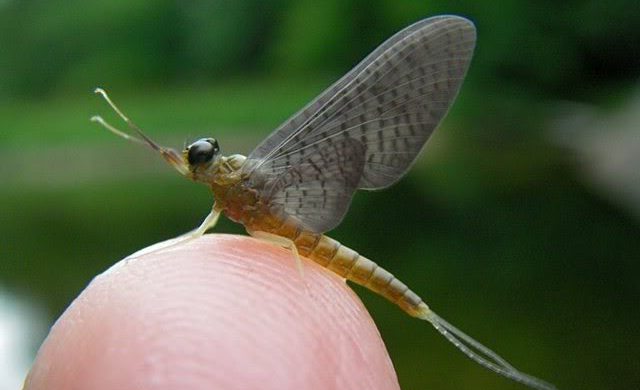You Have Just Entered Our Website...
And we welcome you with a white-gloved
"HOWDY!"

This is a site made by biology students from the
University of Wisconsin - La
Crosse, devoted to the mayfly species Isonychia bicolor.
*Not what you're looking for? Click to return to
MultipleOrganisms.net.*
For another excellent source on water-dwelling bugs, visit the
Aquatic Insect Encyclopedia.
WHAT WOULD
YOU DO
if you only had one day left
to live?
Many have posed, pondered, and attempted to prepare
an answer for this question, but producing a
sufficient response to something so deep and so
vague is never an easy pursuit.
However, this is the case for every mayfly who has
walked, crawled, swum, and flown the planet. You may
have heard this fact and perhaps felt sorrowful (or
if you identify as insect phobic, you might be
saying "thank goodness!"), that this particular
clade (i.e., systematic grouping) of insects is
indeed granted but a single day to be born, progress
through its life stages, reproduce and eventually
pass away into the waters from which it came.
While the truth about mayflies is at first seemingly
sad, this interesting bunch serves a significant
purpose in the lives of several neighboring species
and in the environment throughout its maturation.
Knowing about these functions and processes may help
illuminate the beauty of nature so clearly
pronounced in these short-lived creatures.
Created under the supervision of
Dr. Roger Haro, an entomologist and professor in
the Coulee region of Wisconsin, this website was
designed to provide insight on the habitat,
classification, interactions, life cycle, and
overall ecological role of this particular species
of mayfly and its brief yet important existence here
on Earth.
*Common Names Listed
Above (Just Below Header):
In addition to its scientific name,
Isonychia bicolor ("eye-so-nick-ee-uh
bye-color"),
this species also has a few
nicknames.
"White-Gloved Howdy" - Perhaps the most
common alternate name used for the species, this
refers to the stance in which the critter holds up
its light-colored tarsi (i.e., the segmented outer
portion of insect legs) during periods of rest (Neuswanger
2012). This peculiar behavior can be seen in the
photo at the top of this page, and it only occurs in
the adult form of the animal.
Since the first true larval stage through which this
insect passes is called a "dun" in popular fisherman
jargon, "Mahogany Dun" is another common
name, but it is used in reference to a whole handful
of mayfly species (DeWalt et al. 2010).
"Large Mahogany Dun" is the specific version of
this nickname, reserved for Isonychia bicolor,
which tends to take on a greater size than many
related mayfly species. "Mahogany," of
course, denotes one of the prominent colors on the
insect body (Neuswanger 2012).
They receive the nickname "Leadwing"
based on the organisms' tendency to initially
sink due to their heavy bodies upon molting (its
transition from one life phase to the next). This
struggle actually proves useful from the perspective
of the food chain--their wild, thrashing attempts to
swim can help attract predatory fish (Neuswanger
2012)!
"Slate Drake," is used to describe members of
the family Isonychiidae. This is derived from the
larval form, sometimes known as "drake," and their
"slate" gray hue (Neuswanger 2012).
NOTE: "Leadwing" serves as somewhat of a
dual-purpose name, as it can also refer to this
smoky color of the mayfly's wings seen in dun form,
just upon emerging from the egg (Buckman 2012).
(Information on life cycle stages
here)
Other, less-common nicknames, or slang terms only
used in reference to the mayfly's broader
classifications, include: "Great Red Spinner,"
"Maroon Drake," "Mahogany Drake," "Dark Red Quill,"
"Leadwing Coachman," and "Great Lead-winged
Coachman" (Neuswanger 2012).
For additional relevant, taxonomical (naming)
information regarding Isonychia bicolor
and its various informal names, see
this page by graduate mayfly researcher Jason
Neuswanger.
Table of
Contents:
For the complete taxonomy and distinguishing features of
Isonychia bicolor, visit the
Classification page.
For a summary of life stages and reproduction, feel free to
explore the Reproduction and Life
Cycle page.
(Note: This page also features a short video on the insect's
locomotion, or movement, in larval form!)
If you are interested in how Isonychia bicolor
interacts with and contributes to its environment, visit the
Ecological Role page. This
will include a variety of topics, such as: habitat, feeding habits,
nutrition, interactions with other species, and the practical
and commercial uses of this insect.
To find out additional "fun facts" about this species, take a
look at the Miscellaneous Facts page.
*Return to
MultipleOrganisms.net.*
This website created Spring 2012 by
Alyssa Neumann and Adam Geipel
